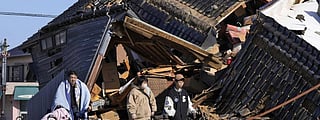
On New Year's Day, an earthquake with a magnitude of 7.6 on the Richter scale shook the west coast of Japan, triggering a tsunami. In its wake, numerous videos purporting to show live footage of the destruction have been circulating on social media. And while many videos do actually show the extent of the natural disaster, others are either old or not even recorded in Japan. Here are three examples gathered by DW's fact checking team:
Claim: This video (archived here), distributed on X (formerly Twitter) with over 127,000 views, shows a river flooding over a road, sweeping away several cars and boats. The user calls for prayers for the people of Japan during this difficult time, implying that the video portrays current events.
DW fact check: False
The video is not from the 2024 earthquake, but was recorded back in 2011 during the Tohoku earthquake (also known as the Great East Japan Earthquake) that triggered a tsunami and the Fukushima nuclear disaster. With the help of a reverse image search using search engines Google and Yandex, we found the original video, which was used by US broadcaster CNN, for example, to report on the extent of that earthquake.
On March 11, 2011, a 9.0 magnitude earthquake struck the main Japanese island of Honshu. It was followed by a tsunami just minutes later, with waves as tall as houses devastating large swathes of land. A wave around 15 meters high caused the power supply that cooled three reactors at Japan's Fukushima nuclear power plant to be disabled, triggering a nuclear disaster.
Claim: In this video (archived), an X user claims: "A dam in Ishikawa Prefecture could not withstand the tsunami that began after the earthquake in Japan." Viewers can see how a deluge rushes through city streets, sweeping away cars and other objects, leaving devastation in the wake. The video has been viewed over 137,000 times and the user implies that it shows recent scenes.
DW fact check: False
This video is also from the abovementioned 2011 earthquake in Japan. Using a reverse image search with TinEye, we found the video in an article by a Japanese media site called Rocket News 24. The video can also be seen in a media report by French TV station TF1.
In recent years, it has been circulated in the wrong context a number of times. In 2020, for example, it was published on Instagram (archived here) with the suggestion that it showed scenes from 2020.
Claim: This video (archived) shows a huge landslide that pours cars, houses and other objects down a valley. The user applied current hashtags such as "Japan" and "earthquake," publishing it in the context of the current disaster. It has been viewed over 840,000 times.
DW fact check: False
This video is also old and out of context. The watermark in the video shows that it was originally distributed on TikTok, but it can no longer be found at that account. Using a reverse image search, we found out that the video showed a landslide in the Japanese city of Atami in 2021.
Using another Google search with the keywords "Japan," "landslide" and "2021," we found several media reports about the incident. According to the Asian Disaster Reduction Center(ADRC), there was indeed a landslide there in July 2021.
Conclusion: Not all videos showing scenes of the earthquake in Japan are false. Many videos that were originally recorded during past events and are currently being re-uploaded and placed in the context of the current natural disaster.
With research from Kathrin Wesolowski and Joscha Weber
(This article has been republished from DW with permission. Read the original article here.)